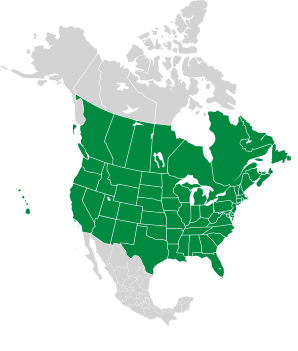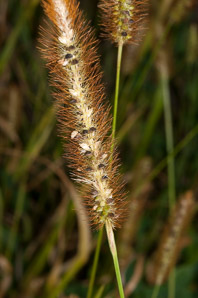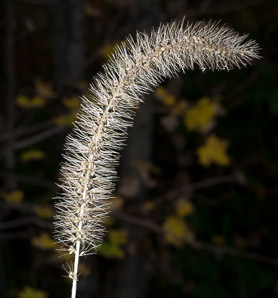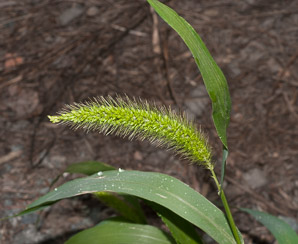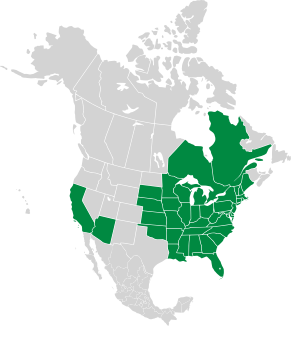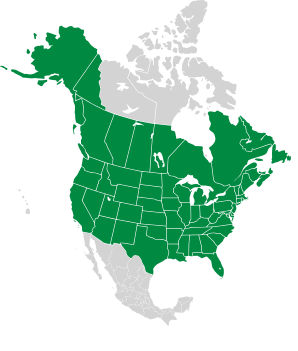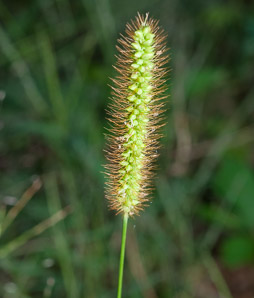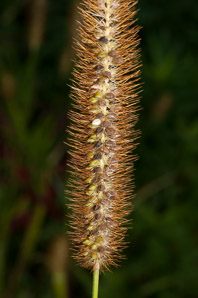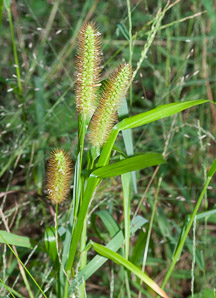
|
Setaria pumila (Poir.) Roem. & Schult. Yellow foxtail, yellow bristlegrass, pigeon grass, cattail grass
A native of Europe and Asia, yellow foxtail is now naturalized and widespread in North America. Identification: Yellow foxtail grows in clumps to heights of 3′ (1 m). Grass blades are flat or sometimes "keeled," folded so they look like the cross-section of a boat, and 4-12″ (10-30 cm) by ⅛-½″ (5-12 mm) wide. Just above the point where the grass blade attaches to the stem, there are a lot of small hairs, called the ligule, on the inside of the blade. (In other related grasses, the ligule looks quite different.) The flowerhead is ¾-6″ (2-15 cm) long and about ⅜″ (1 cm) in diameter, and erect rather than nodding. The flowerhead is made up of spikelets, small seed pods, with bristles that appear yellow at maturity. It blooms from June through December. |
9/25/2010 · Nashua River Rail Trail, Groton Center, Groton, Massachusetts · ≈ 5 × 3½″ (13 × 9.2 cm) 10/15/2008 · Back Yard, Pepperell, Massachusetts · ≈ 7 × 11″ (18 × 27 cm) |
||||||||||||||||||||||||||||
|
Here are the foxtails: | |||||||||||||||||||||||||||||
Setaria faberi |
You are here Setaria pumila |
Setaria viridis |
|||||||||||||||||||||||||||
|---|---|---|---|---|---|---|---|---|---|---|---|---|---|---|---|---|---|---|---|---|---|---|---|---|---|---|---|---|---|
| Common Name |  |
 |
 |
||||||||||||||||||||||||||
| Plant | Plants are 2-5′ (60-152 cm) tall, the largest foxtails, with multiple stems. The grass blades alternate, reaching up to 1′ (38 cm) long and ¾″ (1.9 cm) wide. | Plants grow in clumps to heights of 3′ (1 m). | Plants grow in clumps with erect stems up to 3′ (1 m) high. | ||||||||||||||||||||||||||
| Flowers | Flowerheads are up to 7″ (17 cm) long. Bristly and drooping under its own weight, they are green to light brown or purplish over time.
|
¾-6″ (2-15 cm) long × ⅜″ (1 cm) in diameter, erect. The flowerhead is made up of spikelets with bristles that appear yellow at maturity. It blooms from June through December.
|
Green panicle up to 6″ (15 cm) in length and ¼-⅝″ (8.5-16 mm) around, usually erect, sometimes slightly nodding.
|
||||||||||||||||||||||||||
| Leaves | Not very stiff, often drooping. Upper leaf surfaces usually have scattered fine, stiff, bristled hairs, but they may also be smooth. Leaf blade edges have tiny teeth that make them feel rough. At the base of each grass blade, just above where it connects to the stem, there is a ringlike tuft of white hairs up to ⅛″ (3 mm) long. | Grass blades are flat or sometimes "keeled," 4-12″ (10-30 cm) by ⅛-½″ (5-12 mm). Just above the point where the grass blade attaches to the stem, there are a lot of small hairs (ligule), on the inside of the blade. | Leaf blades are medium dull green, rough but hairless (except sometimes near the edges), and up to 1′ (40 cm) × ⅞″ (2.5 cm). | ||||||||||||||||||||||||||
| Range/ Zones |
|
|
|
||||||||||||||||||||||||||
| Habitats | Meadows, fields, landfills, mined land, construction sites, vacant lots, yard boundaries, gardens, railroads, roadsides, and waste land. | Roadsides, ditch banks, fields, pastures, cropland, orchards, vineyards, gardens, turf, disturbed sites. | Margins of woods, upland prairies, streambanks, pond margins, pastures, fields, lawns, cultivated areas, disturbed sites, roadsides, railroads. | ||||||||||||||||||||||||||
| Type | Wild | Wild | Wild | ||||||||||||||||||||||||||
| Occurrence | Common, sometimes invasive. | Fairly common | Common | ||||||||||||||||||||||||||
Online References:
The Massachusetts Division of Fisheries and Wildlife Natural Heritage & Endangered Species Program
Kansas Wildflowers and Grasses
Invasive.org, Center for Invasive Species and Ecosystem Health
References:
Uva, Richard H.; Neal, Joseph C.; DiTomaso, Joseph M., Weeds of the Northeast, Comstock Publishing Associates, 1997, p. 82 (good comparison between giant, yellow, and green foxtail)
8/25/2009 · Nashua River Rail Trail, East Pepperell, Massachusetts · ≈ 4 × 6″ (10 × 15 cm) ![]() ID is uncertain
ID is uncertain 
9/25/2010 · Nashua River Rail Trail, Groton Center, Groton, Massachusetts · ≈ 4½ × 3″ (11 × 7.9 cm) ![]() ID is uncertain
ID is uncertain 
Setaria pumila description by Thomas H. Kent, last updated 16 Sep 2020.
© FloraFinder.org. All rights reserved.
9/18/2010 · Nashua River Rail Trail, Groton Center, Groton, Massachusetts · ≈ 4½ × 3″ (11 × 7.9 cm) ![]() ID is uncertain
ID is uncertain 
8/25/2009 · Nashua River Rail Trail, East Pepperell, Massachusetts · ≈ 7 × 11″ (18 × 27 cm) ![]() ID is uncertain
ID is uncertain 
Range:
